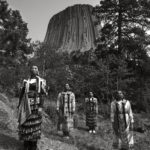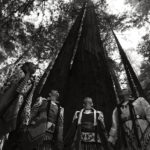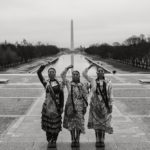Navajo photographer brings Jingle Dress Project and dance of healing around the country
Jul 2, 2021, 10:48 AM | Updated: 12:58 pm
The Jingle Dress Project started with a dream.
Eugene Tapahe is a Navajo photographer who lives in Provo with his family, and in the early months of the pandemic, he lost his aunt who was living on the Navajo Nation to COVID-19.
“It was really hard on us, it really impacted our lives, because she was our last matriarch and our family,” Tapahe said. “So it was also hard for us because, in the Navajo culture, we usually bury our family within four days. And we weren’t able to even get her back into the family until like two weeks later, because they didn’t know at the time what COVID and how the . . . virus was affecting, you know, people when they passed.”
Because the coronavirus was so new, Tapahe and his family couldn’t bury his aunt in their family plot either and they would only allow eight people to attend the service before she was buried in an area for COVID-19 victims.
“As Navajo people we like to celebrate people’s lives as they pass and, and we weren’t able to do that the appropriate way,” Tapahe said.
“So we came back from the reservation, came back into Utah, and at that point in time, I just felt really depressed and was really feeling sad and lonely because I didn’t know what was going to happen.”
But just a few days later, he said he had a dream that he was in Yellowstone National Park.
Field of dreams
“When the dream came, it was, it wasn’t a surprise to me that I was sitting in Yellowstone, and you know, in the field of grass, Tapahe said adding that his family has spent a lot of time in the area and his career as a landscape photographer began in that area.
He said, during this dream he was sitting there watching bison graze in the setting sun when he heard a noise, a tinkling sound from the Jingle Dresses.
“And I started looking around and out of the sides of my dream, these beautiful women started coming into my dream and they were, you know, dancing, the jingle dress dance and, and [I was] hearing the drums and hearing the jingles and seeing them as if they were like united with nature and with the bison. It just really felt really calm, that I felt peaceful, and at that point in time, I really felt like I was healing, healing from my sorrows and everything that was going on around me.”
That feeling was something he wanted to hold on to. When he woke up, he told his wife Sharon, and his daughters Erin and Dion about the dream and wanting to make it become a reality.
“I said, wouldn’t it be cool to be able to make this reality to make this come true, especially during this time with COVID, where everybody needs, healing, and the land needs healing,” Tapahe said. “The one thing I told the girls when I was telling them the dream is that if we can heal the land, we can heal the people.”
“If we can heal the land, we can heal the people”
So they set out to work.
In the middle of the pandemic though, they wouldn’t be able to gather a large group of dancers, so they decided on something smaller, just his daughters, Dion and Erin, and their friends Sunni and JoAnni Begay.
All of the girls attended BYU so they kept their first photoshoot local and went to the Bonneville Salt Flats.
“As we got there, it was a huge rainstorm and, and windy, it was like a whiteout,” Tapahe said.
“But when we got there and the girls were getting the regalia, and I was getting my equipment ready … it was kind of it kind of funny for us because as the girls stood in front of the camera, and I stood behind the camera, there was a quiet pause because we all looked at each other like okay, what do we do now?
“You know, they’re, they’re not professional models, and I’m not a portrait photographer. So, I just told them I said, pose how you think we should, and we just kind of just felt it out that and it was, it was a learning experience for all of us.
Tapahe said after they captured those first few images, things really came together as the girls started to dance.
View this post on Instagram
“We are still finding, and using the healing powers of the jingle dress”
Erin Tapahe said her father’s dream contains a connection to the Jingle Dress history. 100 years ago another father, an Ojibwe man from Minnesota had a daughter suffering from the Spanish Flu in 1918. While wondering what to do, she said he had a dream.
“He dreamt of the dress,” Erin Tapahe said. “He didn’t really know what it was, so then he woke up and told his wife, and then his wife started making four dresses for the women in their community to dance in.”
As those dancers danced, the Ojibwe man’s daughter was healed.
Erin Tapahe found the historical connection impactful.
View this post on Instagram
“We are still finding, and using the healing powers of the jingle dress to bring hope and unity, and then also to bring prayers to — to people, and trying to heal them,” she said.
That connection, to the healing power of the jingle dress that started 100 years ago in the midst of another pandemic was something they wanted to be able to take to the rest of the country, and to the rest of the world.
The Jingle Dress Project begins
As the girls danced on the Salt Flats, Tapahe said everything came together.
“It just made everything . . . come together and made everything — the meaning of the dream and the meaning of everything that we were doing during COVID, it just like, brought everything together,” she said. “I just really felt like, you know . . . this project needs to happen.
When they finished dancing, Tapahe said there was a spiritual feeling that settled on each of them.
“So we had discussions on why and where we were going to take this project. Where we’re going to take it, where we’re going to dance, and I told them, I said you know a great thing we could do is for Native people, not only the people that are here today, but the people that were our ancestors, I said we should go to national and state parks. To make a statement. …
“Because back in when colonization started, those are the first lands that were taken, because they have the plush lands, they had places where water was and animals and food and stuff that they could do to survive.
“And so the Native people were pushed off of those lands first. So I felt like it would make a really huge statement not only to Native people, but non-Native people, to be able to be in these places, the beautiful places that people hold a high regard that we can go and be able to do our photoshoots and to heal the land and to dance there.
“And so that’s kind of where we started.”
So, the six of them, Eugene and his wife Sharon, as well as the four girls started on their journey to historic sites, sacred sites, landmarks, parks and memorials. They danced to heal the land — sometimes alone, sometimes with an audience. At every step of the Jingle Dress Project, Eugene Tapahe was there with his camera.
Connecting to their ancestors and the land
“I think whatever we were feeling in the location that we were at, like, if we were feeling connected to the land, thinking about our ancestors, thinking about our relatives, indigenous communities that have been displaced, or whatever — like, you could feel that through the photo. And so I think all four of us were, were in awe of how powerful the images looked,” Sunni Begay said.
Each of the girls said they couldn’t really pick a spot that meant the most to them, they had special experiences everywhere — Yosemite, Sequoia, Minnesota. According to Eugene Tapahe, as the Jingle Dress Project connected them with their ancestors and the land, it brought healing.
“I think for me, the biggest thing is is that they have learned to appreciate their culture and their traditions. This project has given them a great platform to talk about Native issues, other than just the healing power of the jingle dress, it’s been able to bring awareness to missing and murdered Indigenous women, it’s been bringing awareness to land reclamation for Native people and, and helps others recognize that we are still here.”
The photos, on display at jingledressproject.com and in a gallery, brought worldwide attention and invitations — to more places, not just in the United States, but around the world. They have another trip later this month.
“Our project is about healing, our project is about bringing hope and healing to people,” Eugene Tapahe said. “We’re not here for your entertainment, we’re here with a purpose.”


























